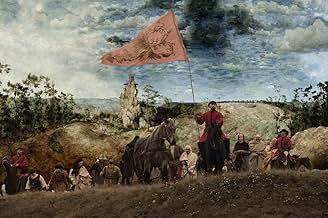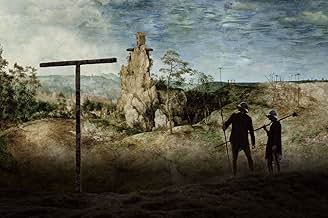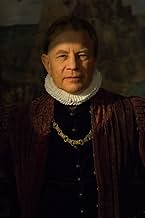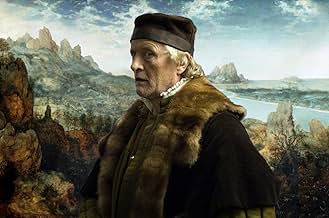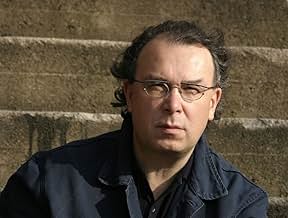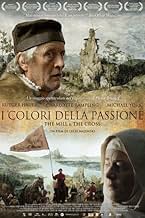IMDb RATING
6.8/10
4.6K
YOUR RATING
This movie focuses on a dozen of the five hundred characters depicted in Bruegel's painting. The theme of Christ's suffering is set against religious persecution in Flanders in 1564.This movie focuses on a dozen of the five hundred characters depicted in Bruegel's painting. The theme of Christ's suffering is set against religious persecution in Flanders in 1564.This movie focuses on a dozen of the five hundred characters depicted in Bruegel's painting. The theme of Christ's suffering is set against religious persecution in Flanders in 1564.
- Director
- Writers
- Stars
- Awards
- 10 wins & 7 nominations total
- Director
- Writers
- All cast & crew
- Production, box office & more at IMDbPro
Featured reviews
The Mill and the Cross (2011)
Maybe I anticipated this for too long, hearing about its production, and teaching in an Art History department myself. The result is both astonishing and boring as heck. I know, there is a kind of absorption that happens through silence and slow appreciation. And there is even the astonishment of looking without really thinking, or feeling, for the narrative or the characters.
This is, for sure, a visually wonderful movie. The way it works out the scenery and milieu of a period based on a single painting is brilliant and ambitious. The mise-en-scene might in fact be the only and singular point of it all. So on that level, eleven stars. Terrific. Mind-blowing.
But that exercise in naturalistic re-creation, in enlivening a masterpiece on canvas by Bruegel from 1564, is not, to me, enough. You will know after ten minutes whether to continue. I have heard of people being just spellbound by it all, so that hopefully would be your feeling.
I tried to make the characters have meaning on some level, either in their interactions, or in their actions alone, or through what they did to the world around them. Much of what happens feels more medieval than Renaissance, to me, but I'm sure that was researched thoroughly. (Bruegel was painting at a time when the Renaissance from Italy had made its way thoroughly north to the lowland countries and beyond.)
It is fun (and indicative of the seriousness here) that both Michael York and Charlotte Rampling took part, late in their careers. That was one of the draws, for sure. But don't expect revelations there, either. Expect in fact only what the director, Lech Majewski, intended—a film version of the painting, set in its larger context but always based on and drawing from this one admittedly fantastic painting. Which might be your starting point, before launching into this one and half hour homage.
Maybe I anticipated this for too long, hearing about its production, and teaching in an Art History department myself. The result is both astonishing and boring as heck. I know, there is a kind of absorption that happens through silence and slow appreciation. And there is even the astonishment of looking without really thinking, or feeling, for the narrative or the characters.
This is, for sure, a visually wonderful movie. The way it works out the scenery and milieu of a period based on a single painting is brilliant and ambitious. The mise-en-scene might in fact be the only and singular point of it all. So on that level, eleven stars. Terrific. Mind-blowing.
But that exercise in naturalistic re-creation, in enlivening a masterpiece on canvas by Bruegel from 1564, is not, to me, enough. You will know after ten minutes whether to continue. I have heard of people being just spellbound by it all, so that hopefully would be your feeling.
I tried to make the characters have meaning on some level, either in their interactions, or in their actions alone, or through what they did to the world around them. Much of what happens feels more medieval than Renaissance, to me, but I'm sure that was researched thoroughly. (Bruegel was painting at a time when the Renaissance from Italy had made its way thoroughly north to the lowland countries and beyond.)
It is fun (and indicative of the seriousness here) that both Michael York and Charlotte Rampling took part, late in their careers. That was one of the draws, for sure. But don't expect revelations there, either. Expect in fact only what the director, Lech Majewski, intended—a film version of the painting, set in its larger context but always based on and drawing from this one admittedly fantastic painting. Which might be your starting point, before launching into this one and half hour homage.
An art movie about the 16th century's arts. It was based on the book of the same name which details the landscaper Pieter Bruegel's painting 'The Procession to Calvary'. A movie specially made for classical painting lovers.
The movie had very less talkings and everything should be learnt by watching the pictures which depicts painting like series of frames. So there's nothing much to talk about the movie. One of the best ever production designs. Frankly, I was less enjoyed due to lack of knowledge about Bruegel, but glad I saw it and come to know few things about 1500s culture through his paintings.
After all, I was not stranger to 'The Procession to Calvary' only by a few weeks before watching this movie. Recently I saw a movie called 'Museum Hours' and it helped a bit to understand this movie. In that movie a guide, an expert briefs in a scene about this painting and the reason behind it.
It was a very unique movie, which still won't exactly portray as it had happened. A glimpse about the idea of it might have been like that. More like an imaginary world created behind the magnificent art work. Not suitable for all, especially those who watch movies for entertainment should stay away from it.
The movie had very less talkings and everything should be learnt by watching the pictures which depicts painting like series of frames. So there's nothing much to talk about the movie. One of the best ever production designs. Frankly, I was less enjoyed due to lack of knowledge about Bruegel, but glad I saw it and come to know few things about 1500s culture through his paintings.
After all, I was not stranger to 'The Procession to Calvary' only by a few weeks before watching this movie. Recently I saw a movie called 'Museum Hours' and it helped a bit to understand this movie. In that movie a guide, an expert briefs in a scene about this painting and the reason behind it.
It was a very unique movie, which still won't exactly portray as it had happened. A glimpse about the idea of it might have been like that. More like an imaginary world created behind the magnificent art work. Not suitable for all, especially those who watch movies for entertainment should stay away from it.
The Mill and the Cross (2011)
The Polish film "The Mill and the Cross" was co-written and directed by Lech Majewski It stars Rutger Hauer as Pieter Bruegel, and co-stars Charlotte Rampling and Michael York.
The film consists of an attempt to bring to life Bruegel's 1564 painting, "The Procession to Calvary." I have seen this painting in the Kunsthistoriche Museum in Vienna. Once you've seen it, you don't forget it, because it is filled with people and action. (Although, in the painting, Jesus has just collapsed under the weight of the cross, so, in a sense, action has been frozen for a few seconds.)
The painting is also remarkable for a very strange symbol--a windmill placed high atop a stony crag. In the film, Bruegel explains that the miller looks down from his mill and sees everything that is happening below, just as God looks down from heaven and can see everything. So, the mill and the miller work symbolically. However, in a practical sense, the mill would never be that high on an large, steep, stony crag. If a mill were really in that location, no one could bring the wheat to the mill or take away the flour.
The other dominant vertical structure is a cartwheel, raised high on a long pole. This was the device used by the Spanish rulers of the Netherlands to execute and display prisoners. The prisoner was tied to the wheel, and the wheel was hoisted far up in the air. The device prevented anyone from helping the person--if alive--or removing the body. Only the carrion birds could reach the body, which they did, with predictable results.
Technology in the 21st Century makes everything possible, so it's no surprise that the painting is reproduced in the film in a real landscape. Sometimes all the figures are frozen, but other times you can see a cow moving or some other action taking place. The special effects are routine by now, but the manner in which they are used is not routine.
We really have the sense that we are looking at a landscape, and the artist is putting it down on canvas before our eyes. This is a highly creative way to look at life the way an artist sees it, and then look at the way life is transformed and committed to canvas.
We saw this film on the large screen at the excellent Rochester Polish Film Festival. It really will work better in a theater. However, if that's not an option, it's worth seeing on DVD.
The Polish film "The Mill and the Cross" was co-written and directed by Lech Majewski It stars Rutger Hauer as Pieter Bruegel, and co-stars Charlotte Rampling and Michael York.
The film consists of an attempt to bring to life Bruegel's 1564 painting, "The Procession to Calvary." I have seen this painting in the Kunsthistoriche Museum in Vienna. Once you've seen it, you don't forget it, because it is filled with people and action. (Although, in the painting, Jesus has just collapsed under the weight of the cross, so, in a sense, action has been frozen for a few seconds.)
The painting is also remarkable for a very strange symbol--a windmill placed high atop a stony crag. In the film, Bruegel explains that the miller looks down from his mill and sees everything that is happening below, just as God looks down from heaven and can see everything. So, the mill and the miller work symbolically. However, in a practical sense, the mill would never be that high on an large, steep, stony crag. If a mill were really in that location, no one could bring the wheat to the mill or take away the flour.
The other dominant vertical structure is a cartwheel, raised high on a long pole. This was the device used by the Spanish rulers of the Netherlands to execute and display prisoners. The prisoner was tied to the wheel, and the wheel was hoisted far up in the air. The device prevented anyone from helping the person--if alive--or removing the body. Only the carrion birds could reach the body, which they did, with predictable results.
Technology in the 21st Century makes everything possible, so it's no surprise that the painting is reproduced in the film in a real landscape. Sometimes all the figures are frozen, but other times you can see a cow moving or some other action taking place. The special effects are routine by now, but the manner in which they are used is not routine.
We really have the sense that we are looking at a landscape, and the artist is putting it down on canvas before our eyes. This is a highly creative way to look at life the way an artist sees it, and then look at the way life is transformed and committed to canvas.
We saw this film on the large screen at the excellent Rochester Polish Film Festival. It really will work better in a theater. However, if that's not an option, it's worth seeing on DVD.
10shunder
It can be said that Lech Majewski's 2011 film depicts "art imitating life, imitating art, imitating life, which also typifies the layer upon layer of meaning and implication to be found in the film. Pieter Bruegel the Elder's 1564 painting "The Way to Calvary" creates the story line for this completely unconventional portrayal of life in the 1600's and Bruegel's technique or the process he may of worked through while creating the painting. Bruegal's painting is much more than a back drop and can almost be seen as a central character, perhaps even a brilliant supporting actor.
As the film weaves in and out of scenes found in the painting, the characters are brought to life portraying their personal reality behind the snippet of time in which they are actually portrayed. In a further layer in the film consider the juxtaposition of good and evil, peasants innocently awaking to begin a day's work, the musicians playing and dancing with merry abandon, contrasted with the whipping and murder of the young husband by the Spaniards. As Bruegel considers the crucifixion scene he actually begins to interact with the painting. He signals to the miller (a euphemism for God) to stop; and as the miller brings the mill (and seemingly life itself) to a standstill the moment is so unsettling as the windmill, looking mysteriously like the cross Christ has suffered on, turns counterclockwise.
The final shot in this lusciously disconcerting film pans out from the painting "The Way to Calvary" as it hangs in Kunsthistorisches Museum in Vienna, and leaves one to ponder the art each of us has seen, and the snapshots in time that art depicts. Majewski's brilliant film gives pause to consider the lives lived behind all the images of all the art over the ages, and so much more.
As the film weaves in and out of scenes found in the painting, the characters are brought to life portraying their personal reality behind the snippet of time in which they are actually portrayed. In a further layer in the film consider the juxtaposition of good and evil, peasants innocently awaking to begin a day's work, the musicians playing and dancing with merry abandon, contrasted with the whipping and murder of the young husband by the Spaniards. As Bruegel considers the crucifixion scene he actually begins to interact with the painting. He signals to the miller (a euphemism for God) to stop; and as the miller brings the mill (and seemingly life itself) to a standstill the moment is so unsettling as the windmill, looking mysteriously like the cross Christ has suffered on, turns counterclockwise.
The final shot in this lusciously disconcerting film pans out from the painting "The Way to Calvary" as it hangs in Kunsthistorisches Museum in Vienna, and leaves one to ponder the art each of us has seen, and the snapshots in time that art depicts. Majewski's brilliant film gives pause to consider the lives lived behind all the images of all the art over the ages, and so much more.
The Mill and the Cross is a movie inside of a painting, specifically The Way to Calvary (1564) by Pieter Bruegel the Elder. Pieter Bruegel (Rutger Hauer) is the main character in the film which takes turns following him as he decides how his painting will take shape and who will be in it and also follows the local peasants who go about their daily business in middle of 16th century Flanders. The background is always the actual painting's background with the mill high up on a rock looking down on a large field where most of the action occurs.
Bruegel's patron is Nicolaes Jonghelinck (Michael York), a successful Flemish banker who spends his time learning from Bruegel about the people in the painting and what each section represents and also pontificates to nobody in particular about the current state of affairs in Flanders. In 1564, Spain ruled what is now Antwerp and Flanders. The Spanish militia seen in the painting in their red tunics seemed to be preoccupied with chasing down and torturing Protestant heretics. There are gruesome scenes in the film with a man tied to a wagon wheel hoisted up in the air with no defense at all while the birds have at him. A woman's fate is no better as she is shoved alive into an open grave while the red tunics fill the dirt in on top of her.
The Way to Calvary itself does not show these particular atrocities. Instead, it has Jesus in the center hoisting his own cross towards his crucifixion. The exact moment the painting captures is Simon helping him with the cross because Jesus stumbled and fell down. Everyone's eyes are on Simon at this time instead of Jesus. In the foreground is Mary (Charlotte Rampling). She is helpless as she sits on the sidelines because there is nothing she can do to prevent the red tunics from carrying out their mission. The rest of the painting shows hundreds of peasants either watching the proceeding or going about their chores. Children play games on the hillside, a local peddler sells his bread, a horn player dances around, and above them all, the miller observes from his windmill.
The Mill and the Cross is at its best when Bruegel is explaining his inspiration and how he plans to incorporate all of his ideas and scenes into one large landscape. He looks closely at a spider's web to discover where the anchor point on his painting will be and how to section off the rest of the action. Just as intriguing are the scenes of everyday life in 1564 Flanders. A young couple gets out of bed and takes their cow to the field for the day. Bruegel's wife and children wake up after him and get ready for breakfast which is a small slice of bread. The miller and his apprentice ready the mill for the day's tasks and the large wheels and gears moan into action.
Rutger Hauer is excellent as Pieter Bruegel and he appears to be serving his artistic penance to atone for his ridiculous participation in Hobo with a Shotgun earlier this year. Michael York is taking a break from his voice over work and TV appearances to finally show up in a serious film again. Charlotte Rampling is sort of the odd man out here. Her screen time is sparse as Mary and she spends most of the time misty eyed observing all of the peasant movements around her.
The Mill and the Cross is a Polish production directed by Lech Majewski who also aided in adapting the screenplay from a book of the same name by Michael Francis Gibson. The film was an official selection at this year's Sundance Film Festival and will most likely earn an Oscar nod for Best Costume Design. The costumes are remarkable and frequently take center stage over the performers.
The Mill and the Cross is a bit reminiscent of The Girl with a Pearl Earring but instead of showing how the painting is made from the outside, this time, the filmmakers actually take you inside of the painting itself and walks on the same landscape as its subjects. There is little dialogue in the film which is not a problem because it is so absorbing to just sit back and watch the peasants wander around the area and Bruegel figure out how to tie everything together. I will not give it away, but the final shot of the film is as wonderful as the rest as the camera backs up and reveals something to the audience.
If you are a movie patron with patience and an interest in art history, The Mill and the Cross is for you. If you get bored in movies without guns, flash bangs, and screaming, stay away.
Bruegel's patron is Nicolaes Jonghelinck (Michael York), a successful Flemish banker who spends his time learning from Bruegel about the people in the painting and what each section represents and also pontificates to nobody in particular about the current state of affairs in Flanders. In 1564, Spain ruled what is now Antwerp and Flanders. The Spanish militia seen in the painting in their red tunics seemed to be preoccupied with chasing down and torturing Protestant heretics. There are gruesome scenes in the film with a man tied to a wagon wheel hoisted up in the air with no defense at all while the birds have at him. A woman's fate is no better as she is shoved alive into an open grave while the red tunics fill the dirt in on top of her.
The Way to Calvary itself does not show these particular atrocities. Instead, it has Jesus in the center hoisting his own cross towards his crucifixion. The exact moment the painting captures is Simon helping him with the cross because Jesus stumbled and fell down. Everyone's eyes are on Simon at this time instead of Jesus. In the foreground is Mary (Charlotte Rampling). She is helpless as she sits on the sidelines because there is nothing she can do to prevent the red tunics from carrying out their mission. The rest of the painting shows hundreds of peasants either watching the proceeding or going about their chores. Children play games on the hillside, a local peddler sells his bread, a horn player dances around, and above them all, the miller observes from his windmill.
The Mill and the Cross is at its best when Bruegel is explaining his inspiration and how he plans to incorporate all of his ideas and scenes into one large landscape. He looks closely at a spider's web to discover where the anchor point on his painting will be and how to section off the rest of the action. Just as intriguing are the scenes of everyday life in 1564 Flanders. A young couple gets out of bed and takes their cow to the field for the day. Bruegel's wife and children wake up after him and get ready for breakfast which is a small slice of bread. The miller and his apprentice ready the mill for the day's tasks and the large wheels and gears moan into action.
Rutger Hauer is excellent as Pieter Bruegel and he appears to be serving his artistic penance to atone for his ridiculous participation in Hobo with a Shotgun earlier this year. Michael York is taking a break from his voice over work and TV appearances to finally show up in a serious film again. Charlotte Rampling is sort of the odd man out here. Her screen time is sparse as Mary and she spends most of the time misty eyed observing all of the peasant movements around her.
The Mill and the Cross is a Polish production directed by Lech Majewski who also aided in adapting the screenplay from a book of the same name by Michael Francis Gibson. The film was an official selection at this year's Sundance Film Festival and will most likely earn an Oscar nod for Best Costume Design. The costumes are remarkable and frequently take center stage over the performers.
The Mill and the Cross is a bit reminiscent of The Girl with a Pearl Earring but instead of showing how the painting is made from the outside, this time, the filmmakers actually take you inside of the painting itself and walks on the same landscape as its subjects. There is little dialogue in the film which is not a problem because it is so absorbing to just sit back and watch the peasants wander around the area and Bruegel figure out how to tie everything together. I will not give it away, but the final shot of the film is as wonderful as the rest as the camera backs up and reveals something to the audience.
If you are a movie patron with patience and an interest in art history, The Mill and the Cross is for you. If you get bored in movies without guns, flash bangs, and screaming, stay away.
Did you know
- TriviaIn the movie, the two large paintings displayed behind Nicolaes Jonghelinck (Michael York) and his wife (Dorota Lis) in their house, are also works by Pieter Bruegel the Elder, "The Tower of Babel" (1563) and "Hunters in the Snow" (1565). They were indeed commissioned or at any rate owned by Jonghelinck at the time.
- GoofsA few minutes before the end of the movie, a red automobile crosses the background between two houses, while Bruegel and Nicholas Jonghelinck are speaking in the foreground.
- SoundtracksMiserere, Opus 44
By Henryk Mikolaj Górecki
Performed by the Silesia Philharmonic Choir (Chorus Master Jan Wojtacha)
- How long is The Mill and the Cross?Powered by Alexa
Details
- Release date
- Countries of origin
- Official site
- Languages
- Also known as
- The Mill and the Cross
- Filming locations
- Wieliczka, Malopolskie, Poland(mill interiors)
- Production companies
- See more company credits at IMDbPro
Box office
- Gross US & Canada
- $312,187
- Opening weekend US & Canada
- $11,354
- Sep 18, 2011
- Gross worldwide
- $1,116,180
- Runtime
- 1h 32m(92 min)
- Color
- Sound mix
- Aspect ratio
- 1.85 : 1
Contribute to this page
Suggest an edit or add missing content


